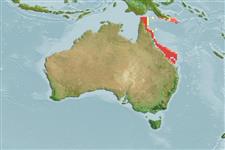Teleostei (teleosts) >
Blenniiformes (Blennies) >
Blenniidae (Combtooth blennies) > Salariinae
Etymology: Ecsenius: Greek, exenios, -os, -on = uncontrolled, immoderate.
Environment: milieu / climate zone / depth range / distribution range
Ecology
Marine; reef-associated. Tropical
Western Pacific: Queensland from Cape York Peninsula at 12°S to the Bunker Group, southern Great Barrier Reef.
Size / Weight / Age
Maturity: Lm ? range ? - ? cm
Max length : 7.5 cm TL male/unsexed; (Ref. 2334)
Dorsal spines (total): 11 - 12; Dorsal soft rays (total): 14 - 16; Anal spines: 2; Anal soft rays: 16 - 18. Dorsal fin XI-XII (typically XII), 14-16 (typically 15). Anal fin II,16-18 (typically 17). Pectoral fin 12 or 13 (rarely 12). Segmented caudal-fin rays 13. Vertebrae 10 or 11 (rarely 11) + 21-24 (rarely 21, usually 23) = 31-34. Dentary incisor teeth which includes anterior canine teeth very similar in appearance from incisors, 45-53; posterior dentary canines (specimens at least 25 mm SL) 3-8 on each side (rarely 3). Lateral line lacking pairs of pores, terminating posteriorly at point between verticals from dorsal-fin spines 9 and 11 (rarely surpassing vertical from 9). With cirrus on posterior rim of anterior nostril; absent on anterior rim.
Adults are found on coastal reefs (Ref. 2334). Oviparous. Eggs are demersal and adhesive (Ref. 205), and are attached to the substrate via a filamentous, adhesive pad or pedestal (Ref. 94114). Larvae are planktonic, often found in shallow, coastal waters (Ref. 94114).
Life cycle and mating behavior
Maturity | Reproduction | Spawning | Eggs | Fecundity | Larvae
Oviparous, distinct pairing (Ref. 205).
Randall, J.E., G.R. Allen and R.C. Steene, 1990. Fishes of the Great Barrier Reef and Coral Sea. University of Hawaii Press, Honolulu, Hawaii. 506 p. (Ref. 2334)
IUCN Red List Status (Ref. 130435: Version 2024-2)
Threat to humans
Harmless
Human uses
Tools
Special reports
Download XML
Internet sources
Estimates based on models
Preferred temperature (Ref.
123201): 24.4 - 28, mean 26.5 °C (based on 385 cells).
Phylogenetic diversity index (Ref.
82804): PD
50 = 0.5000 [Uniqueness, from 0.5 = low to 2.0 = high].
Bayesian length-weight: a=0.00776 (0.00356 - 0.01695), b=3.00 (2.81 - 3.19), in cm total length, based on LWR estimates for this (Sub)family-body shape (Ref.
93245).
Trophic level (Ref.
69278): 2.0 ±0.00 se; based on food items.
Resilience (Ref.
120179): High, minimum population doubling time less than 15 months (Preliminary K or Fecundity.).
Fishing Vulnerability (Ref.
59153): Low vulnerability (10 of 100).
Nutrients (Ref.
124155): Calcium = 195 [93, 344] mg/100g; Iron = 0.965 [0.546, 1.738] mg/100g; Protein = 17.8 [16.6, 18.9] %; Omega3 = 0.0875 [, ] g/100g; Selenium = 25 [12, 59] μg/100g; VitaminA = 112 [27, 471] μg/100g; Zinc = 2.9 [1.9, 4.3] mg/100g (wet weight);
